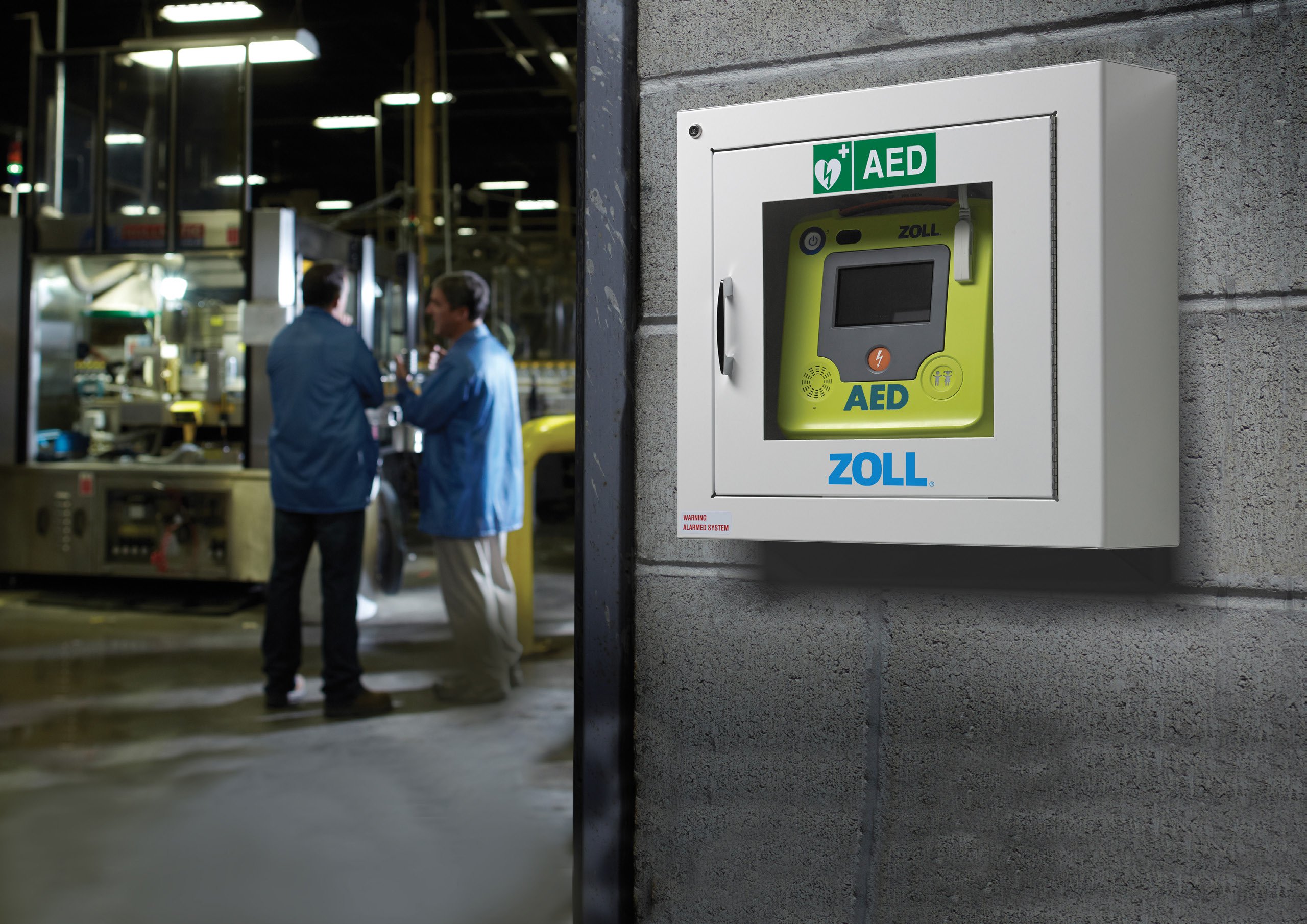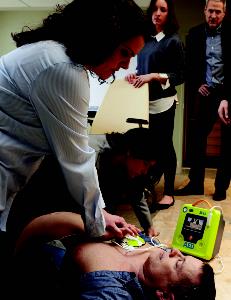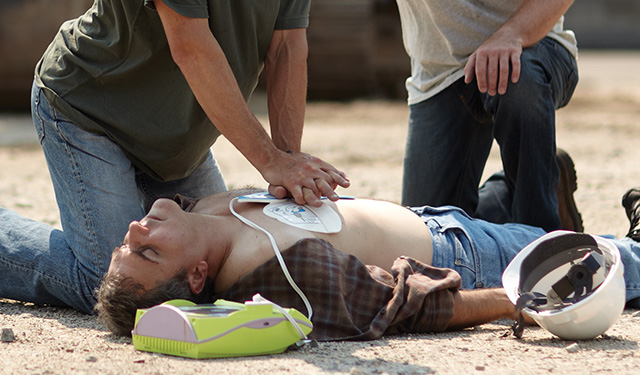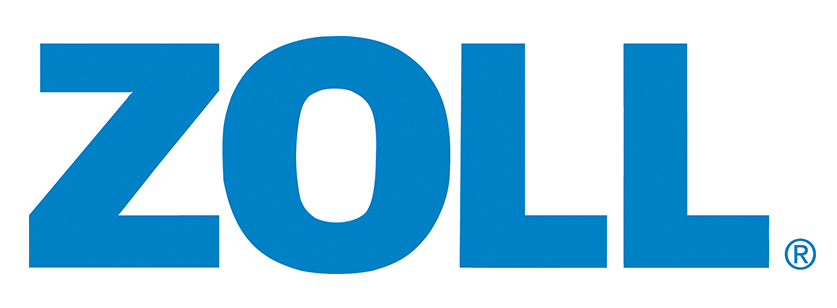October is Sudden Cardiac Arrest (SCA) Awareness Month: Is Your Workplace Prepared to Treat Sudden Cardiac Arrest?

Sudden cardiac arrest (SCA) can happen to anyone, anytime – including during a normal day at work. In fact, according to OSHA, about 10,000 sudden cardiac arrests occur in the workplace each year. That’s why it is critical to implement a comprehensive Automated External Defibrillator (AED) program in your workplace.
 Proper SCA education and tools like an AED can mitigate the above statistic and empower your employees to respond to SCA – because every moment counts. For every minute that defibrillation is delayed, survival rates plummet by 10 percent. Since EMS teams take an average of 7 to 14 minutes to arrive, it’s vital that your workplace is equipped with tools and training that enable you and your colleagues to intervene immediately.
Proper SCA education and tools like an AED can mitigate the above statistic and empower your employees to respond to SCA – because every moment counts. For every minute that defibrillation is delayed, survival rates plummet by 10 percent. Since EMS teams take an average of 7 to 14 minutes to arrive, it’s vital that your workplace is equipped with tools and training that enable you and your colleagues to intervene immediately.
Think about your own workspace: Can you confidently describe where AEDs are located? Each AED should be placed so any employee can easily find it and respond to the victim quickly. It is recommended that AEDs are located within 3 minutes of each other in any facility or building and near trained users. It’s also important to install clear signage and ensure that AEDs are easy to find. Place AEDs in populated areas including break rooms and lobbies, as well as in high-risk areas like fitness centers. If you are unsure of where to place AEDs in your building, your authorized AED dealer can provide an on-site assessment for the best possible outcome.
SAVING LIVES IN THE WORKPLACE WITH A PROPER SCA RESPONSE
You might wonder: Is buying an AED for my workplace really worth it? Many people are uncertain about factors such as ease of use, cost, and maintenance. AEDs are proven to save lives, and having one available in the workplace could mean the difference between life and death. When someone experiences SCA, early defibrillation from an AED is crucial: According to the American Heart Association, survival rates are highest with early defibrillation. Delivering a shock within 3 to 4 minutes of an SCA victim’s collapse can increase their chance of survival by 60%.

11 FACTORS TO CONSIDER WHEN SETTING UP AN AED PROGRAM
As a champion for safety, you play a significant role in protecting your colleagues, advocating for CPR/AED training, and selecting the right AED for your organization. And remember, once you’ve purchased and placed your AEDs, you need to advocate for the use of AEDs to ensure everyone in the workplace is empowered to help. Consider these following 11 tips once you are ready to implement an AED program in your workplace:
- VALUE - Look beyond the price tag. Less-expensive AEDs may require more frequent maintenance and replacement of consumables, which increases costs over the life of the AED. Also, ensure that the AED offers intuitive, comprehensive support for rescuers.
- FEEDBACK - Best-in-class AEDs guide rescuers to deliver chest compressions that meet recognized guidelines and recommendations. Studies show that a victim of cardiac arrest is more than twice as likely to survive when rescued with a defibrillator equipped with real-time CPR feedback. Understanding CPR quality, including how deep and how fast CPR compressions should be, is a key part of AED/CPR training.
- DURABILITY - Cardiac arrest doesn’t always happen indoors or in a controlled environment, so be sure AEDs are dust- and water-resistant, durable, and able to withstand temperature fluctuations and harsh environments.
- RESCUER SUPPORT - To support rescuers with or without training, look for AEDs that provide feedback including easy-to-understand voice and text prompts, and graphics to guide rescuers in performing high-quality CPR throughout the rescue.
- READINESS - Automatic self-testing of internal circuitry, battery, and pads ensures that your AED will be ready at a moment’s notice. ZOLL AEDs feature highly visible readiness indicators, perform regular, comprehensive self-tests, and Wi-Fi functionality for reporting status updates, enabling easy management of large fleets of AEDs.
- PAD LIFE - Electrode pads adhere directly to an SCA victim’s chest and are critical to delivering a shock to the heart. Most pads expire and require replacement every 18-30 months; ZOLL pads can last up to 5 years.
- BATTERY LIFE - Every AED is powered by a battery, and most batteries need to be replaced every 2 to 5 years; ZOLL batteries last from 4 to 5 years in standby mode. That means fewer replacements, less maintenance, and a low total cost of ownership.
- SEMI-AUTOMATIC VS. AUTOMATIC SHOCK DELIVERY - An AED with automatic shock capability analyzes a victim’s heart rhythm and delivers an electric shock automatically if needed (after advising rescuers to stand clear). A semi-automatic AED instructs rescuers to press a button to deliver a shock at the right moment. ZOLL offers AEDs with both semi- and fully automatic capabilities.
- PEDIATRIC USE - AEDs with pediatric pads automatically adjust the amount of energy used to defibrillate younger victims. If you work in a school, daycare, or other workplace where children under the age of eight are present, consider investing in an AED with pediatric capability.
- WARRANTY - Be sure to check the terms of each AED’s warranty. ZOLL AEDs offer warranty protection up to 8 years, which can help to ensure a state of readiness and save money over the lifetime of the device.
- DUAL LANGUAGE - AEDs that provide rescue prompts and CPR instruction in 2 languages can add value by broadening the range of potential rescuers. This feature is especially useful for public access AEDs.
SPREADING AWARENESS OF AEDs IN THE WORKPLACE
 According to the American Heart Association, only 51% of employees can locate an AED in their workplace. Because early defibrillation can mean the difference between life and death, it’s important to help build a culture of awareness. Here’s how you can start doing that today:
According to the American Heart Association, only 51% of employees can locate an AED in their workplace. Because early defibrillation can mean the difference between life and death, it’s important to help build a culture of awareness. Here’s how you can start doing that today:
- Make sure everyone in your workplace knows where your AEDs are located. Place signage that clearly guides employees on where to find AEDs.
- Distribute flyers, emails, or posters with basic facts about SCA to everyone in your organization.
- Create a workplace safety task force that offers regular AED training and certification and encourage all employees to participate.
- Send email blasts to inform all employees about the AED program. Use posters and signage to promote it.
- Encourage employees to ask questions about SCA and using an AED in the workplace.
- Set up a company-wide training program that covers AEDs, workplace safety, and how to respond during an emergency.
When your colleagues know where AEDs are located, know how to use them, and understand the role they play in saving lives, they are empowered to help save lives.
CONNECT WITH SAF-T-GARD TO LEARN MORE
October is SCA Awareness Month, a time to raise awareness about the lifesaving power of CPR and AEDs. Every second counts during an SCA emergency, and quick action with CPR and an AED can mean the difference between life and death. Want to protect your employees and provide added peace of mind? Put ZOLL AEDs in your workplace. Industrial safety is our legacy going back 9 decades. For an overview of our ZOLL AEDs, and to order for immediate shipment, please visit ZOLL.

